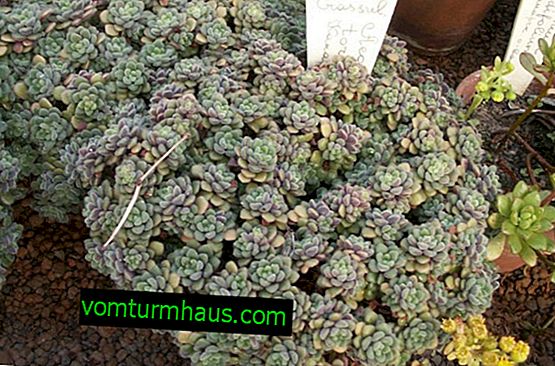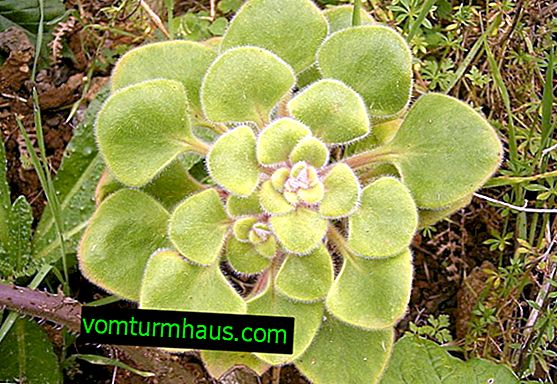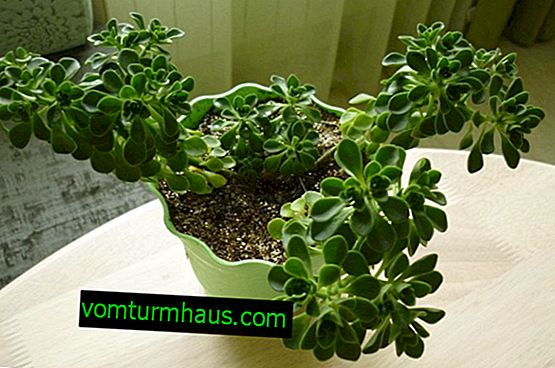Aichrison: a description of the plant, especially home care
Succulents have long earned the attention of flower growers due to their unpretentiousness, interesting forms and ease of reproduction. Such plants are considered achichrison. Everything else, these plants can bloom for a long time. Further on what constitute aichrison, what are the features of their care for them.
Houseplant Description
In total, there are 18 species of aichrison. The homeland of these plants are the Canary and Azores, Madeira and Morocco, and one species grows in Portugal. These are succulents from the family Crassulaceae. Their stems branch well, forming tree-like forms.
Did you know? The botanical name itself is translated from Greek as "always golden." Some guess the shape of the heart in the leaves of achichrison, and it is often called the "tree of love." It is believed that it contributes to the preservation of the family and happiness, therefore, it has another name - "tree of happiness."
Branches and leaves are fragile; foliage is like plush. The plant, which looks like a miniature tree up to 40 cm high, aroused interest among flower growers, and some of its species began to be grown indoors. It usually blooms with small yellow flowers.










































In the houses you can find the following types:
- Clear-leaved (aeonium) . It is characterized by a pear-shaped leaf with a yellowish-green color. Sometimes there is a reddish sticky streak. Short (up to 1.5 cm) foliage is collected in sockets. It blooms only 2 months per year, and during the dormant period leaves fall.

- Sinuous (tortoiseum) . Its leaves are in lighter tones, with a white edge and a rhombus shape. They have shortened petioles and a small size (about 1 cm), also form rosettes. Blooms up to six months.

- Loose (open) . This bush up to 40 cm high also forms rosettes. The leaves are diamond-shaped, with long stalks, up to 3 cm in size. The edge of the white color is discarded by the plant when it fades. The open achichrison blooms for several months - with tassels up to 30 cm long.

- Point . It forms a compact bush with a white edge not only on the foliage, but also on the stems. Its brownish-green branches at the very top end with “rosettes” of leaves.

- Home. Hybrid point and tortuous species. Grows up to 30 cm; characterized by a bright color of leaves with a light strip and a white edge. The leaves resemble a mace in shape. At the top of each branch there is a "rosette". It blooms for a long time (six months), the flowers smell pleasantly. This variety is most in demand.

The plant is very similar to aeoniums - representatives of the family Crassulaceae, growing in the same area. The differences between them are not immediately apparent, but they are.
Did you know? The name of the succulents comes from "sucus", which is translated from Latin as "juice", "gum". And all because these flowers accumulate moisture in the leaves for their survival in the desert climate.
Here are the differences between ichrison and aeoniums:
- they have a small edge on the leaves (and the leaves are smooth on the eonymum);
- longer flowering (up to six months) - in eonymum, flowering lasts less than 2 months;
- the trunk stays green for a long time, and only at the age of 5–6 years the base becomes lignified - at Eonium the stems become strong almost immediately.
Advantages and disadvantages of a plant
- The advantages of this indoor flower are obvious:
- compact size;
- decorative view of a small tree (bush);
- long flowering;
- breeds well;
- the ability to form a bonsai;
- unpretentiousness.
- The disadvantages are:
- fragility;
- the need for a period of rest;
- dropping foliage.
Conditions of detention
The optimum temperature for aichrozones is a range of + 20 ... + 25 ° С, but plants will need a dormant period with a decrease in temperature to + 8 ... + 15 ° С. If it is not possible to provide the plant with such a condition, the plant will not die, but will stretch out and not lay flower stalks. At temperatures above +30 ° C, a period of summer rest begins. Aichrison requires enough light, but it must be scattered. Avoid direct sunlight burning the foliage. On a window facing south, it must be shaded, especially in the summer, when the sun is active.

Important! For uniform crown growth, aichrison should be rotated weekly by 45 °.
Preparation for landing
After a period of adaptation, a plant just bought is recommended to be transplanted into another soil after a week or two, since the store substrate is usually suitable only for transportation. To do this, you need to choose the right capacity and soil mixture.
Capacity selection
The plant forms a small root system, and it does not need a deep flower pot, since unused land has the ability to sour. It is worth staying on a small pot in the form of a bowl. Ceramics will be the best material - it has “breathing” pores (which is important for succulents) and will make the tank heavier. The presence of drainage holes is required.

Soil treatment
For transplanting, you can buy ready-made soil mix for cacti and succulents, or you can mix sod land, humus, leaf soil and sand in a 4: 1: 1: 1 ratio by yourself. For disinfection, it is recommended to calcine in the oven. Be sure to prepare the drainage. Whatever mix you make, it should be loose, and acidity should be in the range of 6.1–6.5 pH.
Breeding and planting technology
Aichrison propagates in two ways - by cuttings and seeds. Seeds have good germination, and properly rooted cuttings take root well. Therefore, any processing of them before use is not carried out. The main thing is to take planting material from a healthy plant.
Learn how to plant indoor flowers in a pot.
Cuttings
Cuttings are cut with a sharp, pre-sanitized knife and dried in a dry, dark place for 2 hours. After this time, they are planted in a container with soil for succulents with the addition of sand. You can mix sand with vermiculite to make the substrate. Cuttings in the soil quickly give root. Already rooted specimens are planted in separate containers with a diameter of about 7 cm.

Important! Cuttings need to be taken from a non-flowering plant, otherwise they will be poorly rooted.
Seeds
For planting, use a mixture of sheet soil and purified sand in a ratio of 2: 1. The seed material is distributed over the surface of the soil and moisturized well. Then the container is transferred to the illuminated place (partial shade or ambient light) with an air temperature of + 18 ... + 20 ºC and covered with glass. Every day you need 10-15 minutes of ventilation. The soil is sprayed, maintaining constant moisture.
After 14 days, shoots appear that need to be dived by planting in a pot at a distance of 1 cm from each other. Soil for such a planting is prepared as follows: 1 part of clean sand, 1 part of light soil and 2 parts of sheet soil are mixed. After the seedlings grow and become stronger, they are transplanted into individual pots with a diameter of 7 cm. In Aichrison, the seeds retain good germination for up to 5 years.

Features of cultivation and care
Aichrison is easy to care for. Regular watering, top dressing, pruning, annual transplanting - all this is necessary for the plant.
Top dressing and watering
Watering should be as necessary with a slight drying of the land between waterings. The flower itself will tell you when it needs moisture. If the leaves are dense and elastic, then it should not be watered, but when the foliage has slightly lost its density, the soil must be moistened. Do not allow the soil to completely dry out or fill the plant too much. Abundant watering after complete drying can cause root decay. A small amount of water is enough, but more often. Its excess from the pallet should be removed.
Important! Like all succulents, aichrison react to water hardness. It is most optimal to water them with rain or melt water (or defend it for about 3 days). To give the water used the necessary softness, it can be slightly acidified with vinegar or citric acid.
During the growing season (spring-summer), watering is carried out more often, and during the dormant period - less often, and moderate drying of the soil is allowed. Once every two weeks during the growing season, the flower is fed with ready-made fertilizers for cacti and succulents. It is important not to overfeed the plant with nitrogen. Succulents can be fed to stimulate flowering with complex mineral fertilizers with nitrogen, phosphorus and potassium in a ratio of 5: 10: 5. When aichrison has waned off, the ratio of these minerals is already different - 5: 5: 5.

Cropping and shaping
Aichrison must be cut off periodically. First of all, it is necessary to remove weak stems and inflorescences that have faded. To make this indoor flower grow more magnificent, you need to pinch off the tops of all the shoots. In spring, pruning of elongated stems is performed.
With the help of pruning, you can give the plant the appearance of a tree or bush, cutting it to the desired shape and getting rid of extra shoots. On these succulents amateurs who have started to master bonsai can train. The main molding is carried out in the spring. Pruning is usually needed during the growing season, since during dormancy, aichrison in the absence of the necessary low temperatures is greatly extended.
Video: spring pruning Aichrison
Dates and technology of transplantation
This plant should be replanted regularly. You can perform this procedure throughout the growing season, but no later than the end of August (it is best to do this in early April). Young plants are replanted annually, and old ones once every 3-4 years, when the roots are already sticking out of the drainage holes. Do not forget that you can transplant a young plant 2 weeks after purchase.
Aichrison transplant technology is as follows:
- One hour before the procedure, water the plant well until the earthen coma is completely wet.
- Carefully remove the flower from the pot and free its roots from the substrate. Rinse the roots with water and inspect them.
- Remove rotten, dry and damaged roots.
- Leave the plant for an hour to dry.
- Pour a drain into the container. As a drainage, you can take broken brick, gravel, polystyrene or buy expanded clay.
- On top of the drainage, it is necessary to fill the finished disinfected soil mixture (but not to the end, but only to a third of the capacity).
- Set the soil in the center of the pot Aichrison, spread its roots.
- Fill with soil and tamp.
- Put a pot with a plant in partial shade.
Important! Arihrizon should not be watered immediately after planting. It is necessary to carry out the first watering in 5-6 days, and after a while to rearrange it in a more illuminated place.
How is the flowering period
In order for a plant to please flowering, the following conditions must be met:
- the capacity should not be too spacious, since the roots will actively grow, mastering free areas and give a lot of leaves (but there will not bloom aichrison);
- watering should not be excessive;
- a rest period in winter is required.

Diseases and Pests
Aichrison may be susceptible to attack by pests.
Among them:
- Shield. You can detect by the appearance of brown plaques and a sticky coating on the foliage. In this case, it is wiped with a sponge dipped in a soap solution, and then treated with preparations of the type "Intavir" or "Actellik".
- Spider mite. It is detected by white blotches on the leaves and by the presence of a web. To eliminate this pest, they increase the humidity and process them with appropriate chemicals (Apollo, Sunmayt).
- Mealybugs. Visible to the naked eye, since they reach approximately 12 mm. The leaf immediately becomes sticky, a white cotton-like coating appears. Insect larvae feed on the sap of the plant, which leads to yellowing and deformation of the foliage. If these insects are found, you will need a soap solution, and the plant is also sprayed with systemic chemicals (Confidor, Actara).
- Nematodes. Small worms measuring about 1–1.5 mm. The leaves, roots are affected, the color changes. Foliage appears stained, dries and crumbles. There are no funds to completely destroy these pests, you can only reduce their number. Therefore, a sick instance is better to destroy.
You may encounter such a problem as leaf fall (especially in spring and summer). All blame the hot sun. The cause may also be overdrying of the earth or, conversely, stagnation of water. If this phenomenon occurs during the cold period, then move the indoor flower to a well-lit, but moderately cool (with a temperature of about +8 ° C) place for the rest period. The frequency and intensity of irrigation is reduced. A curled and wilted leaf indicates a lack of watering. If you constantly allow excessive watering of the plant, then rot will appear, which affects not only the roots of the plant, but also the stems.

Did you know? Unpretentious and unfading succulents are actively used by florists. They became popular for weddings (rustic, eco and boho weddings). They adorn the bride’s bouquet and her hairstyle. Boutonnieres, floral arrangements are used to decorate a wedding feast.
To avoid white edema, you must follow simple rules, caring for this indoor flower:
- prevent crowding of leaves;
- adhere to all recommendations for care;
- if the flower grows slowly, avoid frequent feeding;
- reduce or stop watering during cloudy and cool weather;
- refuse the pan or always pour water out of it;
- use a well-draining soil mixture;
- make top dressing with calcium.








